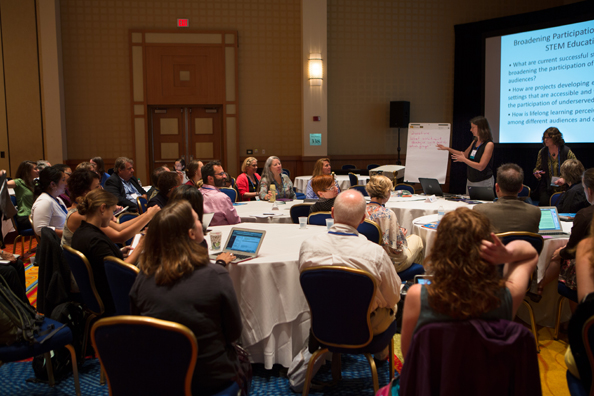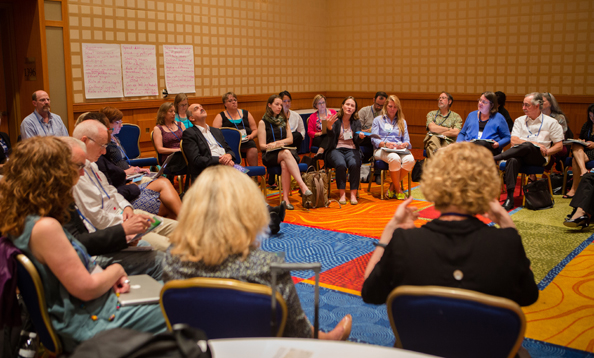Broadening Participation in STEM Education
The Diving Deeper, Looking Forward session topics at the 2014 AISL PI Meeting emerged from a pre-meeting survey of AISL-funded Principal Investigators; discussions with PIs and others who have participated in CAISE convenings over the past two years; and input from CAISE staff, co-PIs, and NSF Program Officers. These sessions were intended to catalyze discussions about cross-sector topics and issues that can continue beyond the meeting and generate new ideas for future projects and collaborations. The following blog post is a summary of questions, issues and ideas expressed by the participants in this session.
Broadening participation—along with workforce development and learning and learning environments—has been deemed one of the core areas for research in the NSF Education & Human Resources (EHR) directorate. Generally construed, “broadening participation” refers to increasing the diversity and number of individuals, geographic regions, types of institutions, and disciplines participating in STEM in order to close achievement gaps within the STEM fields. For informal STEM learning institutions and project leaders, finding new ways to engage all community members is key to their mission and often included in project outcomes. This session at the 2014 AISL PI Meeting sought to consider the following questions:
- What are current successful strategies for broadening the participation of specific audiences?
- How are projects co-designing experiences and settings that are accessible and valuable with the participation of underserved populations?
- How is lifelong learning perceived and valued among different audiences and cultures?
- What recruitment strategies work best for which groups?
- How can we be more intentional about studying retention patterns across different groups?
Session Contributors and Projects
The session contributors included: Laura Peticolas of UC Berkeley’s Space Sciences Lab, who leads the Multiverse project and contributes to the AISL-funded Native Universe project; Nancy Maryboy, President and CEO of the Indigenous Education Institute and PI on Native Universe; Lynn Dierking, a researcher at Oregon State University who is currently working on the Designing Our World project at OMSI, which examines girls’ engagement in engineering; and Jolene Jesse, a Program Officer at NSF in the Research on Gender in Science and Engineering (GSE) program.

Laura Peticolas discusses her collaborative work with Nancy Maryboy.
The contributors shared some of their own experiences and their current research focus in the area of broadening participation. For example, Nancy Maryboy and Laura Peticolas discussed their collaborations in the Native Universe project (which builds off of the Cosmic Serpent project). The project works to build institutional capacity in science museums to educate the public on issues of environmental change as well as human relationships to nature from the perspectives of Indigenous people. One underlying principle of the project is that to effectively engage underrepresented groups, project leaders should tap into the multiple perspectives in a community, and not come with preconceived notions of what is good for the audience. These stances help to address the challenge of making science relevant within the context of a variety of cultures. It is important to make sure that all stakeholders are represented early in the planning process, before a project proposal is written. This can be partially accomplished by identifying “bridge people” who are respected in multiple communities—for example, a scientist who is Latino or Native (as in the Native Universe project).
Contributors also shared some of the current challenges faced by those doing this work. For example, NSF and other funders are interested in identifying long-term outcomes of STEM learning programs—a particular challenge in informal learning. Nevertheless, practitioners believe that informal learning environments can be impactful spaces for leaners to engage with over time and empower them in their knowledge of science content. A huge challenge for NSF and others is collecting the long-term data about learning, and then applying that knowledge to practice. This is particularly true in the informal learning field, where practitioners may come to the field through a variety of career paths, and may not be skilled in rigorous data collection.
Finally, contributors and participants discussed some areas of current and future research on broadening participation. For example, Lynn Dierking described a longitudinal project she is working on in an underresourced community, following a cohort of children for 5 years to track if they sustain or engage with STEM throughout that time. The project is also engaging the community by paying high school students to act as researchers within the community and to collect information about the cohort of younger participants. Lynn raised an issue that has emerged in this and similar projects, which is the need to expand the definition of what “counts” as STEM. For example, in some communities gardening is essential to livelihood—could neighborhood gardeners be considered STEM experts? By expanding definitions and thinking outside of the box, researchers and practitioners may be able to make progress in designing for engagement in underresourced communities.
Questions, Observations and Areas for Further Discussion
The session opened with a group brainstorm about topics to discuss. Some of these were addressed immediately and others catalyzed ideas for Open Space sessions on the following day. Both the Diving Deeper and Open Spaces sessions on broadening participation set the stage for further collaboration and exploration. Below is a summary of these topics and ideas.

Sharing ideas for further research in broadening participation in STEM.
- Diverse ages of learners. Adults, non-parents, early learners, intergenerational learners—lall are areas outside of the typical school-aged youth- or family-centric audience of informal learning environments.
- Media. Creating culturally competent and responsive media programs—involving practitioners/program developers and community stakeholders in the development stages.
- Longitudinal and impact studies. Where are we making a difference—and what does it mean to make a difference? Is the goal to grow more scientists, or to meet community goals, or to promote non-cognitive (i.e. self-efficacy, STEM identity) factors? How do we sustain the impact of interventions over the long term (and measure it)? Do some of our interventions actually prevent, rather than support, access to STEM?
- Broadening definitions of STEM. By re-examining what “counts” as STEM, communities may find a place for themselves.
- Role models. Finding and engaging with STEM-based professionals in the community.
- Logistics. There are a variety of barriers standing in the way of reaching underesourced groups, such as the ability to sustain long-term relationships through staffing, and providing inroads to non-English speakers (not just through literal translation, but also through translating the “culture of science”). How are informal learning institutions navigating those challenges?
- Workforce development. How can the informal learning community share its knowledge base to support practitioners’ goals for helping underrepresented groups navigate the STEM workforce landscape?
Related Resources
These resources were mentioned during the presentation by contributors and participants.
- Chatman, L., Nielsen, K., Strauss, E., and Tanner, K. Girls in Science: A Framework for Action. National Science Teachers Association (NSTA), 2008. Although this is a book written for formal classrooms, it describes hands-on strategies for engaging and approaching learners.
- Dierking, L. and McCreedy, D. Cascading Influences: Long-Term Impacts of STEM Informal Experiences for Girls. Philadelphia, PA: The Franklin Institute, 2013. This report begins to answer the question of what we can expect from informal science in terms of long-term outcomes in STEM. It also asks readers to consider how we define STEM, and creating spaces within informal learning practice for anyone to feel like a scientist and become a scientist.
- Maryboy, N., Begay, D., and Peticolas, L. The Cosmic Serpent: Collaboration with Integrity. Bridging Native Ways of Knowing and Western Science in Museum Settings. A publication describing the planning, implementation, successes, and challenges of the NSF-funded Cosmic Serpent project.
- Ohkee, L. and Buxton, C. Diversity and Equity in Science Education: Research, Policy, and Practice. New York: Teachers College Press, 2010.This book serves as a comprehensive reference to research in multicultural science education. It’s a good place to see what other kinds of projects have been done.
- The work of Glen Aikenhead, Emeritus Professor at the University of Sasketchewan. Dr. Aikenhead’s work has shown that a culturally relevant curriculum can improve science learning not just for Indigenous students, but for all students in the class.
Selected Resources from the Informal Commons
- Cultural processes in science education: Supporting the navigation of multiple epistemologies
- Dimensions of Communication in Urban Science Education: Interactions and Transactions
- Girls, Equity, and STEM in informal Learning Settings: A Review of Literature
- The Girl Game Company: Engaging Latina Girls in Information Technology
- Effective STEM Programs for Adolescent Girls: Three Approaches and Many Lessons Learned
- Expanding Underrepresented Minority Participation: America’s Science and Technology Talent at the Crossroads
- How do Minorities within the Minority Identify with Science and Engineering? A Focus on Middle School Students’ Identity Negotiations Regarding Science
- Intervention Program to Keep Girls in the Science Pipeline: Outcome Differences by Ethnic Status
- New Pathways into Robotics: Strategies for Broadening Participation
- Role Models Matter Toolkit
- Supporting native science and ways of knowing in science education
Special thanks to Emily Schuster for documenting this session.